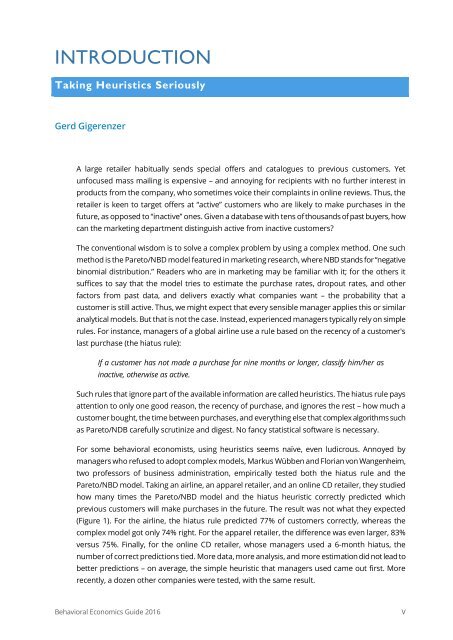THE BEHAVIORAL ECONOMICS GUIDE 2016
BEGuide2016
BEGuide2016
Create successful ePaper yourself
Turn your PDF publications into a flip-book with our unique Google optimized e-Paper software.
INTRODUCTION<br />
Taking Heuristics Seriously<br />
Gerd Gigerenzer<br />
A large retailer habitually sends special offers and catalogues to previous customers. Yet<br />
unfocused mass mailing is expensive – and annoying for recipients with no further interest in<br />
products from the company, who sometimes voice their complaints in online reviews. Thus, the<br />
retailer is keen to target offers at “active” customers who are likely to make purchases in the<br />
future, as opposed to “inactive” ones. Given a database with tens of thousands of past buyers, how<br />
can the marketing department distinguish active from inactive customers?<br />
The conventional wisdom is to solve a complex problem by using a complex method. One such<br />
method is the Pareto/NBD model featured in marketing research, where NBD stands for “negative<br />
binomial distribution.” Readers who are in marketing may be familiar with it; for the others it<br />
suffices to say that the model tries to estimate the purchase rates, dropout rates, and other<br />
factors from past data, and delivers exactly what companies want – the probability that a<br />
customer is still active. Thus, we might expect that every sensible manager applies this or similar<br />
analytical models. But that is not the case. Instead, experienced managers typically rely on simple<br />
rules. For instance, managers of a global airline use a rule based on the recency of a customer's<br />
last purchase (the hiatus rule):<br />
If a customer has not made a purchase for nine months or longer, classify him/her as<br />
inactive, otherwise as active.<br />
Such rules that ignore part of the available information are called heuristics. The hiatus rule pays<br />
attention to only one good reason, the recency of purchase, and ignores the rest – how much a<br />
customer bought, the time between purchases, and everything else that complex algorithms such<br />
as Pareto/NDB carefully scrutinize and digest. No fancy statistical software is necessary.<br />
For some behavioral economists, using heuristics seems naïve, even ludicrous. Annoyed by<br />
managers who refused to adopt complex models, Markus Wübben and Florian von Wangenheim,<br />
two professors of business administration, empirically tested both the hiatus rule and the<br />
Pareto/NBD model. Taking an airline, an apparel retailer, and an online CD retailer, they studied<br />
how many times the Pareto/NBD model and the hiatus heuristic correctly predicted which<br />
previous customers will make purchases in the future. The result was not what they expected<br />
(Figure 1). For the airline, the hiatus rule predicted 77% of customers correctly, whereas the<br />
complex model got only 74% right. For the apparel retailer, the difference was even larger, 83%<br />
versus 75%. Finally, for the online CD retailer, whose managers used a 6-month hiatus, the<br />
number of correct predictions tied. More data, more analysis, and more estimation did not lead to<br />
better predictions – on average, the simple heuristic that managers used came out first. More<br />
recently, a dozen other companies were tested, with the same result.<br />
Behavioral Economics Guide <strong>2016</strong><br />
V


